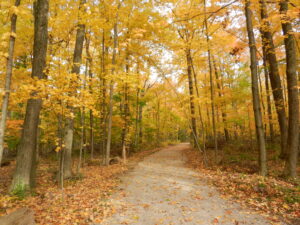By Casey Smith, Naturalist
Skunk cabbage (Symplocarpus foetidus). It’s not what you would commonly think of as a spring wildflower. It’s doesn’t have the visual appeal of spring beauty or trillium. As the name suggests, it stinks. And it emerges early enough that it’s not quite spring.

Flowers under tree canopy must bloom before all the trees have filled with leaves. This is to get as much sunlight as possible. While we often see leaves of emerging plants first, skunk cabbage blooms flower first. The flowers are thermogenic, meaning they produce heat through a chemical process. This melts the snow and ice that may still be on the ground in mid-February when skunk cabbage is often first seen.

The flower has what is called a spathe and spadix. The spathe is a large hood like sheath. Inside the hood is a spadix consisting of a stalk covered with tiny yellowish flowers. As the flower wilts, large dark green cabbage-like leaves unfold, growing 1-3 feet tall. Skunk cabbage grows in soggy places with wet soils, including marshy deciduous woods, wet thickets, swamps, near springs, alongside streams and wetlands, by seeps, and in bogs.
Being one of the first flowers to emerge after winter is a big deal. Bears have been known to eat the young plant. Its foul odor attracts its pollinators, primarily flies and gnats, insects who are naturally attracted to the scent of decomposition. Because of its thermogenic properties, the inside of the otherworldly looking flower can heat up to 70°F, acting as a warm refuge for bees and other insects. The pollen is one of the first available food sources for some of these insects. The yellow throat warbler has been known to build its nest inside the flower to mask its own odor from predators. Once the large leaves emerge, they provide shelter for small reptiles and amphibians.

Skunk cabbage may not be strikingly beautiful, or smell so nice, but it unfolds to support the first life in a habitat just waking up from winter. Look for skunk cabbage growing along the creek that flows through the gravel parking lot at Shale Hollow Park.






